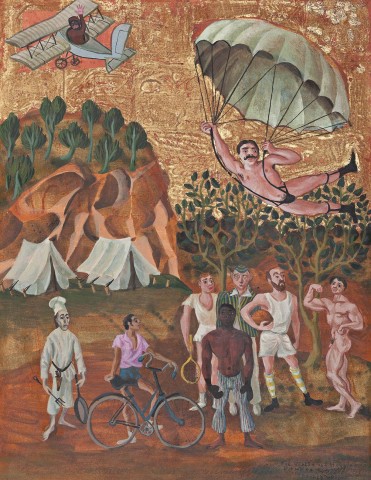THE HEALTH AND HOBBIES FITNESS CAMP, c.1963
DONALD FRIEND
watercolour, gouache and gold leaf on paper on board
63.0 x 48.0 cm
signed and inscribed with title lower right: THE HEALTH and Hobbies / Fitness CAMP. / DONALD FRIEND
bears inscription verso: 1963
Acquired directly from the artist,
Estate of Kerry Hill AO, Singapore
The Health and Hobbies Fitness Camp, c.1963 belongs to a long-running series of paintings by Donald Friend which incorporate the sumptuous finish of gold-leaf. Whilst the genesis of such works may be found in his fascination with religious scenes from the Byzantine era and the early Renaissance, witnessed through repeat visits to Italy, he was further inspired by his study of the art of Ceylon (now Sri Lanka) where he lived in the late 1950s. Evident throughout the series are key flourishes of Friend’s oeuvre – fastidious finish, masterly graphic skills and, above all, a caustic wit which casts a mordant eye over the follies of humanity.
Friend journeyed to Ceylon in 1957, staying at ‘Brief’, the renowned garden estate south of Colombo which belonged to the planter Bevis Bawa. The artist already had experience of living amongst ‘exotic’ peoples, such as his experiences in Africa in his early twenties, and living with Indigenous families in far-North Queensland and on islands in the Torres Strait. In Africa, much of his time was devoted to sketching traditional artworks – in particular, Yoruba (Nigerian) artefacts – a practice he continued in Ceylon. Friend’s incredibly detailed diaries list site after site he visited in order to capture carvings and paintings before they were ruined by nature or, more likely, human intervention. In Italy in 1952, he had followed an allied strategy of making his own ‘Byzantine and early Renaissance-style paintings (including) decorative ‘autobiographical ikons’ … on prepared gilded panels’.1 Friend’s diaries from Ceylon contain multiple entries commenting on his progress with the gold-leaf paintings, culminating in the significant commission executed for the McKinnon Mackenzie shipping company, City of Galle, 1961, which comprises one large, central painting – almost four metres wide – surrounded by numerous small-scale ‘predellas’.
Following his return to Australia in 1962, Friend exhibited the gold-leaf works in Sydney and before that, in Perth where the show was opened by the actress Vivien Leigh.2 Unsettled and depressed after leaving Ceylon, Friend began painting humourous works in his Sydney home in an effort elevate his spirits. Commissions soon followed, including the majestic mural cycle for Sir James Fairfax at ‘Retford Park’, his country property in Bowral; and ‘a series of small [parodic] decorative panels depicting such scenes from Australian history as the arrival of the first rabbit in New South Wales, or Bennelong entertaining Governor Phillip with an obbligato on the didgeridoo’.3 The Health and Hobbies Fitness Camp belongs to these latter painting cycles and features a fantasy meeting of athletes and aesthetes, mingling whilst a circus strongman, with traditional mustache and tights, hovers on a parachute. Intriguingly, it also contains elements from much of Friend’s previous interests and experience, with the setting akin to the grottoes found in paintings by the proto-Renaissance artist Giotto, and the tents being a recollection of his time as an official war artist. In the middle stands a handsome youth of African heritage, and to the side, an Asian chef which is a masterly study in itself, an almost melancholy presence to counter-balance the light-hearted atmosphere of his fellows.
1. Pearce, B., Donald Friend 1915-1989: Retrospective, Art Gallery of New South Wales, Sydney, 1990, p. 81
2. Leigh had famously conducted her affair with Peter Finch at Bevis Bawa’s ‘Brief’ estate in 1953 whilst filming Elephant Walk.
3. Hughes, R., Donald Friend, Edwards and Shaw, Sydney, 1965, p. 74
ANDREW GAYNOR
